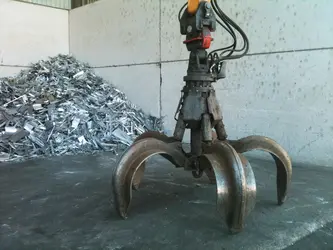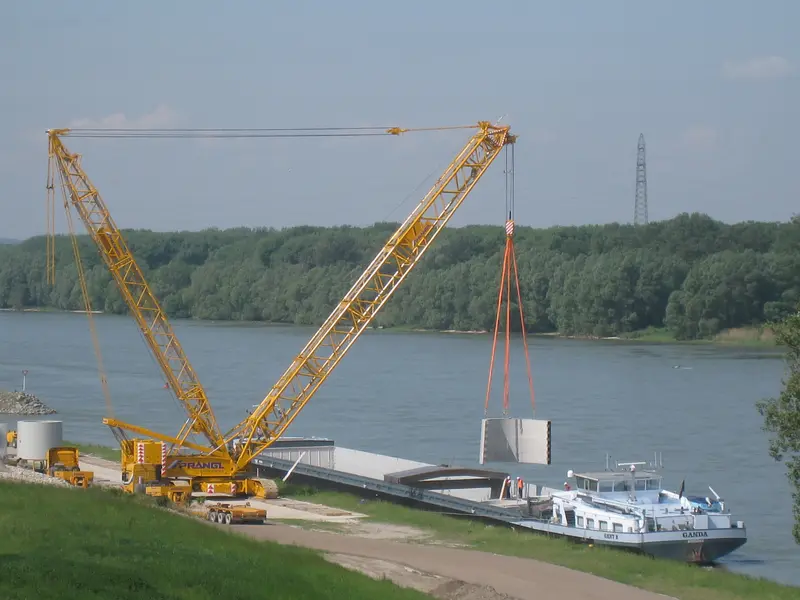The demand side of the inland waterway transport market includes, for the most part, cargo owners, i.e. industrial companies that receive or convey goods. Furthermore, forwarders and logistics service providers are also active in carrying out transport for third parties as well.
Traditional markets for Danube navigation
Due to the large volume of goods that can be transported on a vessel unit, inland navigation vessels are ideally suited to the transportation of bulk goods. If planned and correctly implemented, transport costs can be reduced significantly in comparison to road and rail, a fact that adequately compensates for longer transport times. The inland vessel is especially suitable for the transport of large cargoes of low value goods.
However, the system requires the availability of high-quality logistics services along the waterway (transhipment, storage, processing, collection/distribution). Many companies use Danube navigation as a fixed part of their logistics chain. The immense bulk freight capacity of inland navigation vessels is currently utilised predominantly by the metal industry, agriculture, forestry and the mineral oil industry.
Inland navigation is an extremely important mode of transport for the steel industry. Approximately 25-30% of the total amount of all raw materials, ore for example, is transported on the Austrian stretch of the Danube. Due to their heavy weight, semi-finished and finished goods such as steel coils can also be transported economically using inland navigation.
The most important steelworks in Austria is voestalpine, which is located in Linz. This company operates its own port at its steelworks and has an annual waterside transhipment of 3-4 million tons. This is also Austria’s most important port, which has been responsible for the handling of almost half of all waterside transhipment in Austria in recent years.
Other major steel plants in the Danube region are located at Dunaújváros/Hungary (ISD Dunaferr Group) and Galați/Romania (ArcelorMittal).

Demand, and therefore also the flow of goods, from the agriculture and forestry sector can fluctuate greatly from one year to the next. Agriculture is dependent to a great extent on weather conditions (precipitation, temperature, days of sunshine per year). Crop failures in a region due to bad weather conditions can lead to an increase in the volume of transported goods required to cover the needs of the respective. Grain and oilseed are the main products transported on the Danube. The transportation of wood is also growing in importance due to the increasing demand from processing industries and biomass plants. Agricultural and forestry products together account for around 20% of the total volume of goods transported annually on the Austrian stretch of the Danube. Many companies in Austria trading in agricultural products or involved in the processing of such goods (i.e. starch, foodstuffs and animal fodder, biogenic fuel, timber) have settled directly on the waterway. Many companies have already set up factory transhipment sites or have settled in a port where they operate their silos or processing plants. This enables transport on inland vessels with no pre- or end-haulage, thereby enabling companies to benefit from particularly low transport costs.
Petroleum products from the mineral oil industry account for another 20% of the total transport volume on the Austrian stretch of the Danube and therefore constitute a major market. In the Danube region there are many refineries located either on or near the Danube.
Due to their great bulk freight capacity, low transportation costs and high level of safety, inland vessels are predestined as a significant means of transport for petroleum products in addition to pipelines. The fuel tanks of around 20,000 cars can be filled with the cargo of a single tanker. Petroleum products and their derivatives are classed as hazardous goods and for this reason are transported in special shipping units equipped with the respective safety equipment.
European regulations and national hazardous goods legislation have particular relevance for tanker shipping.
Other branch-specific potentials for Danube navigation
In addition to traditional bulk cargo transport, there are numerous sectors involved in the transport of high-value goods, which, due to their specific requirements, represent a great challenge but at the same time a substantial potential for the development of logistics services along the waterway.
Due to their size and the available infrastructure, inland vessels are ideally suited for special transport such as heavy goods or oversized loads (“high & heavy”), e.g. construction machinery, generators, turbines or wind power plants. The greatest advantage here compared to conventional road transport is that no special modifications need to be made along route, e.g. the dismantling of traffic lights and traffic signs or protective covers for plants. Another benefit is the fact that there is no inconvenience to the general public due to street closures, restrictions on overtaking or noise when such goods are transported by inland vessel.
The Danube has also developed today to become a logistics axis of pan- European importance for the bundling, storage and processing of biogenic (renewable) raw materials (e.g. grain, oilseed, log wood). The increasing shortage of non-renewable resources and the creation of cross-sector value-added chains that result from this (e.g. the food and fodder industry, chemical industry and energy generation sector) enable the development of new types of cargo on the Danube.
Transport costs can be reduced and the negative impact on the environment minimised thanks to targeted improvement in logistic services available on the Danube (port infrastructure, special transhipment equipment) and the operation of inland vessels along the resource-intensive value-added chains. This entails the necessity of logistics chains that meet the high requirements of the respective goods.

Recycling products are mainly bulk goods of relatively low value and are therefore not usually associated with time-critical transport. Because of these characteristics, inland navigation is an interesting option for waste management. In principle, all waste material can be transported by inland vessels, regardless of whether it is in the form of bulk cargo or general cargo. The major urban areas located directly on the Danube (e.g. Vienna, Bratislava, Budapest and Belgrade) are reliable suppliers of scrap metal, waste plastic, waste glass and other secondary raw materials. The energetic utilisation of waste by power plants is currently leading to an additional demand for the transportation of waste.
A favourable development can also be expected in Central and Southern Europe as far as the construction material industry is concerned. This is due mainly to the high requirements of renovating and expanding the infrastructure, although structural and civil engineering projects and residential construction also play a significant role. The resulting transport volumes and growing exchange of goods with Southern Europe suggest a high potential for inland navigation. Inland vessels could be used here for both bulk cargoes (e.g. mineral raw materials) as well as general cargo (e.g. construction materials and construction machinery).

Strategies such as just-in-time or just-in-sequence are among the determining factors for success or failure in the automotive industry. Due to their long transport times, inland vessels only play a role in such logistic chains with the transportation of less time-critical components. However, specific potential can be exploited (high transport capacity, low transport costs) with the use of RoRo ships for the transportation of new vehicles due to the high concentration of production plants in the Danube region (e.g. in Slovakia and Romania).
Another major sector is fertilisers, which are currently being transported in large quantities on the Danube. These account for approximately 10% of the total transport volume on the Austrian Danube stretch. Plants from the petrochemical industry are often found in the immediate vicinity of refineries. These plants manufacture plastics and other oil-based products from oil derivatives and by-products. Due to its great bulk freight capacity Danube navigation is also the ideal solution for this market segment. However, financially viable concepts for the pre- and end-haulage are required here. Combined transport represents an attractive alternative for integrating transportation by inland vessel into the logistics chain of the chemical industry, along with the construction of warehouses for bulk goods.

